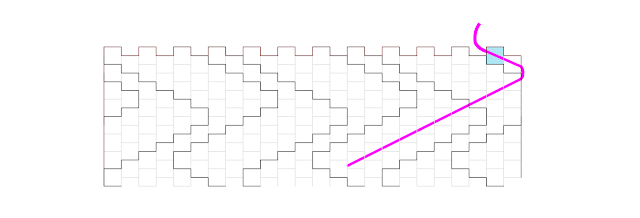When I moved to Cornwall twenty years ago, I knew very little about Cornish history and heritage but I was very interested in finding out more about this beautiful place. I expected to only be here a few years, but I met a Cornishman and never left. One of the many things I had no idea about was Cornish Tartan.
It's common to know about Scottish tartans, particularly if you have Scottish ancestry as I do, but tartan is a celtic tradition. It is believed that the Cornish wore tartans of some sort as there are references to garments that were checkered or freckled. Altarnun Church, which dates back to 1510, was found to have carvings of people wearing kilts by the historian and poet L.C.R. Duncombe-Jewell.
Cornwall did not have clan tartans in the same way as Scotland though and the tartans now registered with Scottish Tartans Authority are all of more modern design. The first of these was the Cornish National Tartan which was registered in 1963 having been designed by E.E. Morton-Nance. Each part of the design relates to an aspect of Cornish history and identity.
Before Cornwall became Cornwall it was the kingdom of Dumnonia and this encompassed all of Cornwall and Devon with part of Somerset and Dorset. This kingdom existed between the 4th and 8th centuries with territory gradually reducing as the Saxons advanced, pushing Dumnonia back to Cornwall. In 1066 the last surviving member of the Cornish royalty, Cadoc, was made Earl of Cornwall by William I of England following the Norman Conquest.
The history of the ancient kingdom of Dumnonia has been rendered particularly murky because of it's close ties to Arthurian legend. It's believed Arthur was of the royal Cornish line and born at the castle of Tintagel and that he died in the Battle of Camlann believed to have been fought at Slaughter Bridge near Camelford.
Legend has it that Arthurs spirit took the form of a Chough when he died. Some versions say the bird was originally a Crow but it's legs and beaks were turned red by the blood of the battleground. The legend also stated that if the Chough ever left Cornwall, it's return would herald the return of King Arthur. The bird did become extinct in Cornwall with the last breeding recorded in 1947 but returned in 2001. There are now a number of breeding pairs!
The Chough is a member of the Corvidae family of birds that includes Crows and the red beak and legs are it's distinguishing feature. It has long been associated with Cornwall and it is considered very bad luck to kill one. As the emblem of Cornwall it is part of the logo for Cornwall Council.
St Piran is the patron saint of Cornwall and the flag of Cornwall is known as St Piran's flag and is black with a white cross. Legend has it that he came from Ireland where he was tied to a millstone and cast in to the sea by some heathens. Perran Bay is a beautiful sandy bay, backed by sand dunes and it is here, at Perranzabuloe that he reached Cornwall. He became a hermit there and established the first Oratory which was later replaced by a stone building. The oratory was abandoned in the tenth century when it was engulfed by sand. It was excavated in 1910 but then reburied.
St Piran is the patron saint of tin-miners and is credited with the rediscovery of how to smelt tin as this art had been lost after the Romans left. It is believed his hearthstone was made of tin bearing rock and the fire caused some of the tin in the rock to melt.
Cornwall is known for it's long history of mining, not just tin but other metals too and stone for building. The sea is never far distant either, no matter where you are in the county.
So the colours chosen reflect aspects of Cornish history... Black and gold were the colours of the Kings of Dumnonia. Black and white are the colours of St Piran and the tartan features the white cross on a black background. The blue is for the sea and the red is for the Chough and the blood of Arthur. I like to think the black is also for the Chough!
It's not surprising I was inspired by the Cornish Tartan! It was a tricky project though. Many tartan or plaid patterns are completed using a loom or turned in to diamonds in peyote patterns. I wanted to get the whole pattern in and keep it as square as possible. I eventually realised that having it at an angle would allow the pattern to be fully represented. I have the pattern as an A4 which I may also release as a chart and I would also like release a brooch pattern which I have developed but not made as yet. This bracelet pattern is the first, for now!
Want to look at the images which inspired me on pinterest?

































































